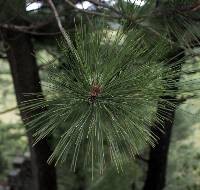Red pine
(Pinus hartwegii)

Description
Pinus resinosa, known as red pine (also Norway pine in Minnesota), is a pine native to North America. It occurs from Newfoundland west to Manitoba, and south to Pennsylvania, with several smaller, disjunct populations occurring in the Appalachian Mountains in Virginia and West Virginia, as well as a few small pockets in extreme northern New Jersey and northern Illinois.The red pine is Minnesota's state tree. In Minnesota the use of the name "Norway" may stem from early Scandinavian immigrants who likened the American red pines to the Scots pines back home. Red pine is a coniferous evergreen tree characterized by tall, straight growth in a variety of habitats. It usually ranges from 20–35 m (66–115 ft) in height and 1 m (3 ft 3 in) in trunk diameter, exceptionally reaching 43.77 m (143 ft 7 in) tall. The crown is conical, becoming a narrow rounded dome with age. The bark is thick and gray-brown at the base of the tree, but thin, flaky and bright orange-red in the upper crown; the tree's name derives from this distinctive character. Some red color may be seen in the fissures of the bark. The species is self pruning; there tend not to be dead branches on the trees, and older trees may have very long lengths of branchless trunk below the canopy. The leaves are needle-like, dark yellow-green, in fascicles of two, 12–18 cm (4+3⁄4–7 in) long, and brittle. The leaves snap cleanly when bent; this character, stated as diagnostic for red pine in some texts, is however shared by several other pine species. The cones are symmetrical ovoid, 4–6 cm (1+1⁄2–2+1⁄4 in) long by 2.5 cm (1 in) broad, and purple before maturity, ripening to nut-blue and opening to 4–5 cm (1+1⁄2–2 in) broad, the scales without a prickle and almost stalkless. Red pine is a coniferous evergreen tree characterized by tall, straight growth in a variety of habitats. It usually ranges from 20–35 m (66–115 ft) in height and 1 m (3 ft 3 in) in trunk diameter, exceptionally reaching 43.77 m (143 ft 7 in) tall. The crown is conical, becoming a narrow rounded dome with age. The bark is thick and gray-brown at the base of the tree, but thin, flaky and bright orange-red in the upper crown; the tree's name derives from this distinctive character. Some red color may be seen in the fissures of the bark. The species is self pruning; there tend not to be dead branches on the trees, and older trees may have very long lengths of branchless trunk below the canopy.
Taxonomic tree:







